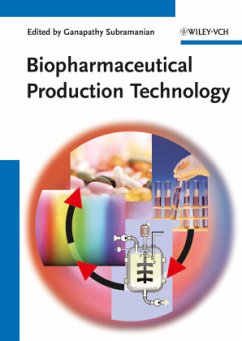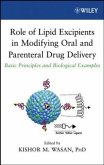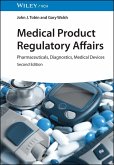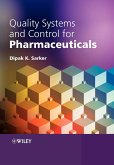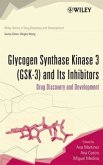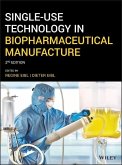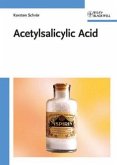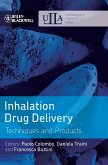Biopharmaceutical Production Technology, 2 Vols.
Ed. by Ganapathy Subramanian
Biopharmaceutical Production Technology, 2 Vols.
Ed. by Ganapathy Subramanian
- Gebundenes Buch
- Merkliste
- Auf die Merkliste
- Bewerten Bewerten
- Teilen
- Produkt teilen
- Produkterinnerung
- Produkterinnerung
Cost-effective manufacturing of biopharmaceutical products is rapidly gaining in importance, while healthcare systems across the globe are looking to contain costs and improve efficiency. To adapt to these changes, industries need to review and streamline their manufacturing processes.
This two volume handbook systematically addresses the key steps and challenges in the production process and provides valuable information for medium to large scale producers of biopharmaceuticals.
It is divided into seven major parts: - Upstream Technologies - Protein Recovery - Advances in Process…mehr
Andere Kunden interessierten sich auch für
![Role of Lipid Excipients in Modifying Oral and Parenteral Drug Delivery Role of Lipid Excipients in Modifying Oral and Parenteral Drug Delivery]() Kishor M. Wasan (ed.)Role of Lipid Excipients in Modifying Oral and Parenteral Drug Delivery151,99 €
Kishor M. Wasan (ed.)Role of Lipid Excipients in Modifying Oral and Parenteral Drug Delivery151,99 €![Medical Product Regulatory Affairs Medical Product Regulatory Affairs]() John J. TobinMedical Product Regulatory Affairs69,99 €
John J. TobinMedical Product Regulatory Affairs69,99 €![Quality Systems and Controls for Pharmaceuticals Quality Systems and Controls for Pharmaceuticals]() Dipak Kumar SarkarQuality Systems and Controls for Pharmaceuticals82,99 €
Dipak Kumar SarkarQuality Systems and Controls for Pharmaceuticals82,99 €![Glycogen Synthase Kinase 3 (Gsk-3) and Its Inhibitors Glycogen Synthase Kinase 3 (Gsk-3) and Its Inhibitors]() Ana Martinez / Ana Castro / Miguel Medina (eds.)Glycogen Synthase Kinase 3 (Gsk-3) and Its Inhibitors210,99 €
Ana Martinez / Ana Castro / Miguel Medina (eds.)Glycogen Synthase Kinase 3 (Gsk-3) and Its Inhibitors210,99 €![Single-Use Technology in Biopharmaceutical Manufacture Single-Use Technology in Biopharmaceutical Manufacture]() Single-Use Technology in Biopharmaceutical Manufacture202,99 €
Single-Use Technology in Biopharmaceutical Manufacture202,99 €![Acetylsalicylic Acid Acetylsalicylic Acid]() Karsten SchrörAcetylsalicylic Acid48,99 €
Karsten SchrörAcetylsalicylic Acid48,99 €![Inhalation Drug Delivery Inhalation Drug Delivery]() Paolo ColomboInhalation Drug Delivery89,99 €
Paolo ColomboInhalation Drug Delivery89,99 €-
-
-
Cost-effective manufacturing of biopharmaceutical products is rapidly gaining in importance, while healthcare systems across the globe are looking to contain costs and improve efficiency. To adapt to these changes, industries need to review and streamline their manufacturing processes.
This two volume handbook systematically addresses the key steps and challenges in the production process and provides valuable information for medium to large scale producers of biopharmaceuticals.
It is divided into seven major parts:
- Upstream Technologies
- Protein Recovery
- Advances in Process Development
- Analytical Technologies
- Quality Control
- Process Design and Management
- Changing Face of Processing
With contributions by around 40 experts from academia as well as small and large biopharmaceutical companies, this unique handbook is full of first-hand knowledge on how to produce biopharmaceuticals in a cost-effective and quality-controlled manner.
Hinweis: Dieser Artikel kann nur an eine deutsche Lieferadresse ausgeliefert werden.
This two volume handbook systematically addresses the key steps and challenges in the production process and provides valuable information for medium to large scale producers of biopharmaceuticals.
It is divided into seven major parts:
- Upstream Technologies
- Protein Recovery
- Advances in Process Development
- Analytical Technologies
- Quality Control
- Process Design and Management
- Changing Face of Processing
With contributions by around 40 experts from academia as well as small and large biopharmaceutical companies, this unique handbook is full of first-hand knowledge on how to produce biopharmaceuticals in a cost-effective and quality-controlled manner.
Hinweis: Dieser Artikel kann nur an eine deutsche Lieferadresse ausgeliefert werden.
Produktdetails
- Produktdetails
- Verlag: Wiley-VCH
- 1. Auflage
- Seitenzahl: 884
- Erscheinungstermin: 18. Juli 2012
- Englisch
- Abmessung: 244mm x 177mm x 51mm
- Gewicht: 2060g
- ISBN-13: 9783527330294
- ISBN-10: 3527330291
- Artikelnr.: 34548271
- Herstellerkennzeichnung Die Herstellerinformationen sind derzeit nicht verfügbar.
- Verlag: Wiley-VCH
- 1. Auflage
- Seitenzahl: 884
- Erscheinungstermin: 18. Juli 2012
- Englisch
- Abmessung: 244mm x 177mm x 51mm
- Gewicht: 2060g
- ISBN-13: 9783527330294
- ISBN-10: 3527330291
- Artikelnr.: 34548271
- Herstellerkennzeichnung Die Herstellerinformationen sind derzeit nicht verfügbar.
Dr. Ganapathy Subramanian is a biotechnology consultant with over 30 years experience in industry and academia, encompassing the application and development of processing, purification methodologies, and chromatographic systems for largescale use in environmental science, food science, perfumery, cosmetics, and pharmaceuticals. He has also taught extensively in the area of food and medical technology.
A chemistry graduate from Madras, India, Dr. Subramanian was awarded his doctorate, from the University of Glasgow, for work on natural products. His main research interests lie in the utilization of natural material separation processes and bioconversions.
Dr. Subramanian has written and edited a number of books and articles in the field of biotechnology. For the last 10 years, he has been organizing conferences promoting the integration and sharing of knowledge between academia and industry.
A chemistry graduate from Madras, India, Dr. Subramanian was awarded his doctorate, from the University of Glasgow, for work on natural products. His main research interests lie in the utilization of natural material separation processes and bioconversions.
Dr. Subramanian has written and edited a number of books and articles in the field of biotechnology. For the last 10 years, he has been organizing conferences promoting the integration and sharing of knowledge between academia and industry.
PREFACE
Volume 1
PART ONE: Upstream Technologies
STRATEGIES FOR PLASMID DNA PRODUCTION IN ESCHERICHIA COLI
Introduction
Requirements for a Plasmid DNA Production Process
Structure of a DNA Vaccine Production Process
Choice of Antigen
Vector DNA Construct
Host Strains
Cultivation Medium and Process Conditions
Lysis/Extraction of Plasmid DNA
Purification
Formulation
Conclusions
ADVANCES IN PROTEIN PRODUCTION TECHNOLOGIES
Introduction
Glycoengineering for Homogenous Human-Like Glycoproteins
Bacteria as Protein Factories
Mammalian Cell Technology
Yeast Protein Production
Baculovirus - Insect Cell Technology
Transgenic Animal Protein Production
Plant Molecular Farming
Cell-Free Protein Production
Future Prospects
PART TWO: Protein Recovery
RELEASING BIOPHARMACEUTICAL PRODUCTS FROM CELLS
Introduction
Cell Structure and Strategies for Disruption
Cell Mechanical Strength
Homogenization
Bead Milling
Chemical Treatment
Cellular Debris
Conclusions
CONTINUOUS CHROMATOGRAPHY (MULTICOLUMN COUNTERCURRENT SOLVENT GRADIENT PURIFI CATION) FOR PROTEIN
PURIFI CATION
Introduction
Overview of Continuous Chromatographic Processes
Principles of MCSGP
Application Examples of MCSGP
Enabling Features and Economic Impact of MCSGP
Annex 1: Chromatographic Process Decision Tree
VIRUS-LIKE PARTICLE BIOPROCESSING
Introduction
Upstream Processing
Downstream Processing
Analysis
Conclusions
Nomenclature
THERAPEUTIC PROTEIN STABILITY AND FORMULATION
Introduction
Protein Stability
Formulation and Materials
Screening Methods
Accelerated and Long-Term Stability Testing
Analytical Techniques for Stability Testing
Conclusions
PRODUCTION OF PEGYLATED PROTEINS
Introduction
General Considerations
PEGylation Chemistry
PEGylated Protein Purification
Conclusions
PART THREE: Advances in Process Development
AFFINITY CHROMATOGRAPHY: HISTORICAL AND PROSPECTIVE OVERVIEW
History and Role of Affinity Chromatography in the Separation Sciences
Overview of Affinity Chromatography: Theory and Methods
Affinity Ligands
Affinity Ligands in Practice: Biopharmaceutical Production
Conclusions and Future Perspectives
HYDROXYAPATITE IN BIOPROCESSING
Introduction
Materials and Interaction Mechanisms
Setting up a Separation
Separation Examples
Conclusions
MONOLITHS IN BIOPROCESSING
Introduction
Properties of Chromatographic Monoliths
Monolithic Analytical Columns for Process Analytical Technology Applications
Monoliths for Preparative Chromatography
Enzyme Reactors
Conclusions
MEMBRANE CHROMATOGRAPHY FOR BIOPHARMACEUTICAL MANUFACTURING
Membrane Adsorbers - Introduction and Technical Specifications
Comparing Resins and Membrane Adsorbers
Membrane Chromatography Applications and Case Studies
Conclusions
MODELING AND EXPERIMENTAL MODEL PARAMETER DETERMINATION WITH QUALITY BY DESIGN FOR BIOPROCESSES
Introduction
QbD Fundamentals
Process Modeling and Experimental Model Parameter Determination
Process Robustness Study
Conclusions
Nomenclature
Volume 2
PART FOUR: Analytical Technologies
BIOSENSORS IN THE PROCESSING AND ANALYSIS OF BIOPHARMACEUTICALS
Introduction
Principles and Commercial Applications of Biosensors
Use of Biosensors in Biopharmaceutical Production and Processing
Conclusions
PROTEOMICS TOOLKIT: APPLICATIONS IN PROTEIN BIOLOGICAL PRODUCTION AND METHOD DEVELOPMENT
Introduction
Applications of Proteomics
Myths and Misconceptions - Perceived Drawbacks of Proteomics
Critical Factors for Industrialization of Proteomics
Case Studies
Conclusions
SCIENCE OF PROTEOMICS: HISTORICAL PERSPECTIVES AND POSSIBLE ROLE IN HUMAN HEALTHCARE
Science of 'Omics'
Major Advances in Biology That Led to the Sciences of 'Omics'
Mendel's Principles of Inheritance
One Gene/One Enzyme Concept of Beadle and Tatum
Watson - Crick Structure of DNA
Development of Different Technologies Responsible for the Emergence of Genomics and Proteomics
Genomics
Proteomics
Interactomics: Complexity of an Organism Based on the Interactions of Proteins
Relation between Diseases, Genes, and Proteins: Diseasome Concept
Proteins as Biomarkers of Human Diseases
Metabolomics
Proteomics and Drug Discovery
Current and Future Benefits of Proteomics in Human Healthcare
PART FIVE: Quality Control
CONSISTENCY OF SCALE-UP FROM BIOPROCESS DEVELOPMENT TO PRODUCTION
Inhomogeneities in Industrial Fed-Batch Processes
Effects of Conditions in Industrial-Scale Fed-Batch Processes on the Main Carbon Metabolism
Effects of Conditions in Industrial-Scale Fed-Batch Processes on Amino Acid Synthesis
Scale-Down Reactors for Imitating Large-Scale Fed-Batch Process Conditions at the Laboratory Scale
Improved Two-Compartment Reactor System to Imitate Large-Scale Conditions at the Laboratory Scale
Description of the Hydrodynamic Conditions in the PFR Part of the Presented Two-Compartment Reactor
Description of Oxygen Transfer in the PFR Part of the Two-Compartment Reactor
E. coli Fed-Batch Cultivations in the Two-Compartment Reactor System
Future Perspectives for the Application of a Two-Compartment Reactor
SYSTEMATIC APPROACH TO OPTIMIZATION AND COMPARABILITY OF BIOPHARMACEUTICAL GLYCOSYLATION THROUGHOUT THE DRUG LIFE CYCLE
Costs of Inconsistent, Unoptimized Drug Glycosylation
Scheme 1: Traditional Approach to Comparability of Drug Glycosylation
Scheme 2: Comparability of Drug Glycosylation Using QbD DS
Scheme 3: Enhanced QbD Approach to Comparability of Drug Glycosylation
Conclusions
QUALITY AND RISK MANAGEMENT IN ENSURING THE VIRUS SAFETY OF BIOPHARMACEUTICALS
Introduction
QRM and Virus Safety
Pillars of Safety
Committee for Proprietary Medicinal Products Guidelines for Investigational Medicinal Products - Risk Management in Practice
Developing a Robust Risk Minimization Strategy - What Is the Correct Paradigm?
ENSURING QUALITY AND EFFI CIENCY OF BIOPROCESSES BY THE TAILORED APPLICATION OF PROCESS ANALYTICAL TECHNOLOGY AND QUALITY BY DESIGN
Introduction
PAT and QbD in Bioprocessing - Engineering Meets Biology
Aspects of Biological Demands - Selected Examples
Technical and Engineering Solutions
Conclusions
PART SIX: Process Design and Management
BIOPROCESS DESIGN AND PRODUCTION TECHNOLOGY FOR THE FUTURE
Introduction
Analysis of Biomanufacturing Technologies
AAC: Anything and Chromatography
Process Integration
Process Design and QbD
Package Unit Engineering and Standardization
Downstream of Downstream Processing
Conclusions
INTEGRATED PROCESS DESIGN: CHARACTERIZATION OF PROCESS AND PRODUCT DEFINITION OF DESIGN SPACES
Introductory Principles
Original Process Development Paradigm
The Essential QbD Concepts
Conclusion
EVALUATING AND VISUALIZING THE COST-EFFECTIVENESS AND ROBUSTNESS OF BIOPHARMACEUTICAL MANUFACTURING STRATEGIES
Introduction
Scope of Research on Decision-Support Tools for the Biotech Sector
Capturing Process Robustness Under Uncertainty
Reconciling Multiple Conflicting Outputs Under Uncertainty
Searching Large Decision Spaces Efficiently
Integrating Stochastic Simulation with Multivariate Analysis
Conclusions
PART SEVEN: Changing Face of Processing
FULL PLASTICS: CONSEQUENT EVOLUTION IN PHARMACEUTICAL BIOMANUFACTURING
FROM VIAL TO WAREHOUSE
Increased Demand, Reduced Volumes, and Maximum Flexibility - Driving Force to Plastic Devices
Plastic - The Flexible All-Round Replacer: From Material to Function
Pollution with Plastics: Leachables and Extractables
Plastics for Storage: Vial and Bag
Plastics for Cultivation: Flask, Tube, and Unstirred and Stirred Bioreactor
Plastics for Purification: Column and Membrane
Case Study: Comparability of Plastic Bag-Based Bioreactors in Cultivation Processes
Conclusions and Prospects
BIOSMB - TECHNOLOGY: CONTINUOUS COUNTERCURRENT CHROMATOGRAPHY ENABLING A FULLY DISPOSABLE PROCESS
Introduction
Continuous Chromatography in Biopharmaceutical Industries
Process Design Principles
Case Studies
Conclusions
SINGLE-USE TECHNOLOGY: OPPORTUNITIES IN BIOPHARMACEUTICAL PROCESSES
Current Single-Use Technologies
Future Single-Use Operations
Automation Requirements in Single-Use Manufacturing
Qualification and Validation Expectations
Operator Training
SINGLE-USE BIOTECHNOLOGIES AND MODULAR MANUFACTURING ENVIRONMENTS INVITE PARADIGM SHIFTS IN BIOPROCESS DEVELOPMENT AND BIOPHARMACEUTICAL MANUFACTURING
Introduction
Paradigm Shift at Crucell
Conclusions and General Outlook
Volume 1
PART ONE: Upstream Technologies
STRATEGIES FOR PLASMID DNA PRODUCTION IN ESCHERICHIA COLI
Introduction
Requirements for a Plasmid DNA Production Process
Structure of a DNA Vaccine Production Process
Choice of Antigen
Vector DNA Construct
Host Strains
Cultivation Medium and Process Conditions
Lysis/Extraction of Plasmid DNA
Purification
Formulation
Conclusions
ADVANCES IN PROTEIN PRODUCTION TECHNOLOGIES
Introduction
Glycoengineering for Homogenous Human-Like Glycoproteins
Bacteria as Protein Factories
Mammalian Cell Technology
Yeast Protein Production
Baculovirus - Insect Cell Technology
Transgenic Animal Protein Production
Plant Molecular Farming
Cell-Free Protein Production
Future Prospects
PART TWO: Protein Recovery
RELEASING BIOPHARMACEUTICAL PRODUCTS FROM CELLS
Introduction
Cell Structure and Strategies for Disruption
Cell Mechanical Strength
Homogenization
Bead Milling
Chemical Treatment
Cellular Debris
Conclusions
CONTINUOUS CHROMATOGRAPHY (MULTICOLUMN COUNTERCURRENT SOLVENT GRADIENT PURIFI CATION) FOR PROTEIN
PURIFI CATION
Introduction
Overview of Continuous Chromatographic Processes
Principles of MCSGP
Application Examples of MCSGP
Enabling Features and Economic Impact of MCSGP
Annex 1: Chromatographic Process Decision Tree
VIRUS-LIKE PARTICLE BIOPROCESSING
Introduction
Upstream Processing
Downstream Processing
Analysis
Conclusions
Nomenclature
THERAPEUTIC PROTEIN STABILITY AND FORMULATION
Introduction
Protein Stability
Formulation and Materials
Screening Methods
Accelerated and Long-Term Stability Testing
Analytical Techniques for Stability Testing
Conclusions
PRODUCTION OF PEGYLATED PROTEINS
Introduction
General Considerations
PEGylation Chemistry
PEGylated Protein Purification
Conclusions
PART THREE: Advances in Process Development
AFFINITY CHROMATOGRAPHY: HISTORICAL AND PROSPECTIVE OVERVIEW
History and Role of Affinity Chromatography in the Separation Sciences
Overview of Affinity Chromatography: Theory and Methods
Affinity Ligands
Affinity Ligands in Practice: Biopharmaceutical Production
Conclusions and Future Perspectives
HYDROXYAPATITE IN BIOPROCESSING
Introduction
Materials and Interaction Mechanisms
Setting up a Separation
Separation Examples
Conclusions
MONOLITHS IN BIOPROCESSING
Introduction
Properties of Chromatographic Monoliths
Monolithic Analytical Columns for Process Analytical Technology Applications
Monoliths for Preparative Chromatography
Enzyme Reactors
Conclusions
MEMBRANE CHROMATOGRAPHY FOR BIOPHARMACEUTICAL MANUFACTURING
Membrane Adsorbers - Introduction and Technical Specifications
Comparing Resins and Membrane Adsorbers
Membrane Chromatography Applications and Case Studies
Conclusions
MODELING AND EXPERIMENTAL MODEL PARAMETER DETERMINATION WITH QUALITY BY DESIGN FOR BIOPROCESSES
Introduction
QbD Fundamentals
Process Modeling and Experimental Model Parameter Determination
Process Robustness Study
Conclusions
Nomenclature
Volume 2
PART FOUR: Analytical Technologies
BIOSENSORS IN THE PROCESSING AND ANALYSIS OF BIOPHARMACEUTICALS
Introduction
Principles and Commercial Applications of Biosensors
Use of Biosensors in Biopharmaceutical Production and Processing
Conclusions
PROTEOMICS TOOLKIT: APPLICATIONS IN PROTEIN BIOLOGICAL PRODUCTION AND METHOD DEVELOPMENT
Introduction
Applications of Proteomics
Myths and Misconceptions - Perceived Drawbacks of Proteomics
Critical Factors for Industrialization of Proteomics
Case Studies
Conclusions
SCIENCE OF PROTEOMICS: HISTORICAL PERSPECTIVES AND POSSIBLE ROLE IN HUMAN HEALTHCARE
Science of 'Omics'
Major Advances in Biology That Led to the Sciences of 'Omics'
Mendel's Principles of Inheritance
One Gene/One Enzyme Concept of Beadle and Tatum
Watson - Crick Structure of DNA
Development of Different Technologies Responsible for the Emergence of Genomics and Proteomics
Genomics
Proteomics
Interactomics: Complexity of an Organism Based on the Interactions of Proteins
Relation between Diseases, Genes, and Proteins: Diseasome Concept
Proteins as Biomarkers of Human Diseases
Metabolomics
Proteomics and Drug Discovery
Current and Future Benefits of Proteomics in Human Healthcare
PART FIVE: Quality Control
CONSISTENCY OF SCALE-UP FROM BIOPROCESS DEVELOPMENT TO PRODUCTION
Inhomogeneities in Industrial Fed-Batch Processes
Effects of Conditions in Industrial-Scale Fed-Batch Processes on the Main Carbon Metabolism
Effects of Conditions in Industrial-Scale Fed-Batch Processes on Amino Acid Synthesis
Scale-Down Reactors for Imitating Large-Scale Fed-Batch Process Conditions at the Laboratory Scale
Improved Two-Compartment Reactor System to Imitate Large-Scale Conditions at the Laboratory Scale
Description of the Hydrodynamic Conditions in the PFR Part of the Presented Two-Compartment Reactor
Description of Oxygen Transfer in the PFR Part of the Two-Compartment Reactor
E. coli Fed-Batch Cultivations in the Two-Compartment Reactor System
Future Perspectives for the Application of a Two-Compartment Reactor
SYSTEMATIC APPROACH TO OPTIMIZATION AND COMPARABILITY OF BIOPHARMACEUTICAL GLYCOSYLATION THROUGHOUT THE DRUG LIFE CYCLE
Costs of Inconsistent, Unoptimized Drug Glycosylation
Scheme 1: Traditional Approach to Comparability of Drug Glycosylation
Scheme 2: Comparability of Drug Glycosylation Using QbD DS
Scheme 3: Enhanced QbD Approach to Comparability of Drug Glycosylation
Conclusions
QUALITY AND RISK MANAGEMENT IN ENSURING THE VIRUS SAFETY OF BIOPHARMACEUTICALS
Introduction
QRM and Virus Safety
Pillars of Safety
Committee for Proprietary Medicinal Products Guidelines for Investigational Medicinal Products - Risk Management in Practice
Developing a Robust Risk Minimization Strategy - What Is the Correct Paradigm?
ENSURING QUALITY AND EFFI CIENCY OF BIOPROCESSES BY THE TAILORED APPLICATION OF PROCESS ANALYTICAL TECHNOLOGY AND QUALITY BY DESIGN
Introduction
PAT and QbD in Bioprocessing - Engineering Meets Biology
Aspects of Biological Demands - Selected Examples
Technical and Engineering Solutions
Conclusions
PART SIX: Process Design and Management
BIOPROCESS DESIGN AND PRODUCTION TECHNOLOGY FOR THE FUTURE
Introduction
Analysis of Biomanufacturing Technologies
AAC: Anything and Chromatography
Process Integration
Process Design and QbD
Package Unit Engineering and Standardization
Downstream of Downstream Processing
Conclusions
INTEGRATED PROCESS DESIGN: CHARACTERIZATION OF PROCESS AND PRODUCT DEFINITION OF DESIGN SPACES
Introductory Principles
Original Process Development Paradigm
The Essential QbD Concepts
Conclusion
EVALUATING AND VISUALIZING THE COST-EFFECTIVENESS AND ROBUSTNESS OF BIOPHARMACEUTICAL MANUFACTURING STRATEGIES
Introduction
Scope of Research on Decision-Support Tools for the Biotech Sector
Capturing Process Robustness Under Uncertainty
Reconciling Multiple Conflicting Outputs Under Uncertainty
Searching Large Decision Spaces Efficiently
Integrating Stochastic Simulation with Multivariate Analysis
Conclusions
PART SEVEN: Changing Face of Processing
FULL PLASTICS: CONSEQUENT EVOLUTION IN PHARMACEUTICAL BIOMANUFACTURING
FROM VIAL TO WAREHOUSE
Increased Demand, Reduced Volumes, and Maximum Flexibility - Driving Force to Plastic Devices
Plastic - The Flexible All-Round Replacer: From Material to Function
Pollution with Plastics: Leachables and Extractables
Plastics for Storage: Vial and Bag
Plastics for Cultivation: Flask, Tube, and Unstirred and Stirred Bioreactor
Plastics for Purification: Column and Membrane
Case Study: Comparability of Plastic Bag-Based Bioreactors in Cultivation Processes
Conclusions and Prospects
BIOSMB - TECHNOLOGY: CONTINUOUS COUNTERCURRENT CHROMATOGRAPHY ENABLING A FULLY DISPOSABLE PROCESS
Introduction
Continuous Chromatography in Biopharmaceutical Industries
Process Design Principles
Case Studies
Conclusions
SINGLE-USE TECHNOLOGY: OPPORTUNITIES IN BIOPHARMACEUTICAL PROCESSES
Current Single-Use Technologies
Future Single-Use Operations
Automation Requirements in Single-Use Manufacturing
Qualification and Validation Expectations
Operator Training
SINGLE-USE BIOTECHNOLOGIES AND MODULAR MANUFACTURING ENVIRONMENTS INVITE PARADIGM SHIFTS IN BIOPROCESS DEVELOPMENT AND BIOPHARMACEUTICAL MANUFACTURING
Introduction
Paradigm Shift at Crucell
Conclusions and General Outlook
PREFACE
Volume 1
PART ONE: Upstream Technologies
STRATEGIES FOR PLASMID DNA PRODUCTION IN ESCHERICHIA COLI
Introduction
Requirements for a Plasmid DNA Production Process
Structure of a DNA Vaccine Production Process
Choice of Antigen
Vector DNA Construct
Host Strains
Cultivation Medium and Process Conditions
Lysis/Extraction of Plasmid DNA
Purification
Formulation
Conclusions
ADVANCES IN PROTEIN PRODUCTION TECHNOLOGIES
Introduction
Glycoengineering for Homogenous Human-Like Glycoproteins
Bacteria as Protein Factories
Mammalian Cell Technology
Yeast Protein Production
Baculovirus - Insect Cell Technology
Transgenic Animal Protein Production
Plant Molecular Farming
Cell-Free Protein Production
Future Prospects
PART TWO: Protein Recovery
RELEASING BIOPHARMACEUTICAL PRODUCTS FROM CELLS
Introduction
Cell Structure and Strategies for Disruption
Cell Mechanical Strength
Homogenization
Bead Milling
Chemical Treatment
Cellular Debris
Conclusions
CONTINUOUS CHROMATOGRAPHY (MULTICOLUMN COUNTERCURRENT SOLVENT GRADIENT PURIFI CATION) FOR PROTEIN
PURIFI CATION
Introduction
Overview of Continuous Chromatographic Processes
Principles of MCSGP
Application Examples of MCSGP
Enabling Features and Economic Impact of MCSGP
Annex 1: Chromatographic Process Decision Tree
VIRUS-LIKE PARTICLE BIOPROCESSING
Introduction
Upstream Processing
Downstream Processing
Analysis
Conclusions
Nomenclature
THERAPEUTIC PROTEIN STABILITY AND FORMULATION
Introduction
Protein Stability
Formulation and Materials
Screening Methods
Accelerated and Long-Term Stability Testing
Analytical Techniques for Stability Testing
Conclusions
PRODUCTION OF PEGYLATED PROTEINS
Introduction
General Considerations
PEGylation Chemistry
PEGylated Protein Purification
Conclusions
PART THREE: Advances in Process Development
AFFINITY CHROMATOGRAPHY: HISTORICAL AND PROSPECTIVE OVERVIEW
History and Role of Affinity Chromatography in the Separation Sciences
Overview of Affinity Chromatography: Theory and Methods
Affinity Ligands
Affinity Ligands in Practice: Biopharmaceutical Production
Conclusions and Future Perspectives
HYDROXYAPATITE IN BIOPROCESSING
Introduction
Materials and Interaction Mechanisms
Setting up a Separation
Separation Examples
Conclusions
MONOLITHS IN BIOPROCESSING
Introduction
Properties of Chromatographic Monoliths
Monolithic Analytical Columns for Process Analytical Technology Applications
Monoliths for Preparative Chromatography
Enzyme Reactors
Conclusions
MEMBRANE CHROMATOGRAPHY FOR BIOPHARMACEUTICAL MANUFACTURING
Membrane Adsorbers - Introduction and Technical Specifications
Comparing Resins and Membrane Adsorbers
Membrane Chromatography Applications and Case Studies
Conclusions
MODELING AND EXPERIMENTAL MODEL PARAMETER DETERMINATION WITH QUALITY BY DESIGN FOR BIOPROCESSES
Introduction
QbD Fundamentals
Process Modeling and Experimental Model Parameter Determination
Process Robustness Study
Conclusions
Nomenclature
Volume 2
PART FOUR: Analytical Technologies
BIOSENSORS IN THE PROCESSING AND ANALYSIS OF BIOPHARMACEUTICALS
Introduction
Principles and Commercial Applications of Biosensors
Use of Biosensors in Biopharmaceutical Production and Processing
Conclusions
PROTEOMICS TOOLKIT: APPLICATIONS IN PROTEIN BIOLOGICAL PRODUCTION AND METHOD DEVELOPMENT
Introduction
Applications of Proteomics
Myths and Misconceptions - Perceived Drawbacks of Proteomics
Critical Factors for Industrialization of Proteomics
Case Studies
Conclusions
SCIENCE OF PROTEOMICS: HISTORICAL PERSPECTIVES AND POSSIBLE ROLE IN HUMAN HEALTHCARE
Science of 'Omics'
Major Advances in Biology That Led to the Sciences of 'Omics'
Mendel's Principles of Inheritance
One Gene/One Enzyme Concept of Beadle and Tatum
Watson - Crick Structure of DNA
Development of Different Technologies Responsible for the Emergence of Genomics and Proteomics
Genomics
Proteomics
Interactomics: Complexity of an Organism Based on the Interactions of Proteins
Relation between Diseases, Genes, and Proteins: Diseasome Concept
Proteins as Biomarkers of Human Diseases
Metabolomics
Proteomics and Drug Discovery
Current and Future Benefits of Proteomics in Human Healthcare
PART FIVE: Quality Control
CONSISTENCY OF SCALE-UP FROM BIOPROCESS DEVELOPMENT TO PRODUCTION
Inhomogeneities in Industrial Fed-Batch Processes
Effects of Conditions in Industrial-Scale Fed-Batch Processes on the Main Carbon Metabolism
Effects of Conditions in Industrial-Scale Fed-Batch Processes on Amino Acid Synthesis
Scale-Down Reactors for Imitating Large-Scale Fed-Batch Process Conditions at the Laboratory Scale
Improved Two-Compartment Reactor System to Imitate Large-Scale Conditions at the Laboratory Scale
Description of the Hydrodynamic Conditions in the PFR Part of the Presented Two-Compartment Reactor
Description of Oxygen Transfer in the PFR Part of the Two-Compartment Reactor
E. coli Fed-Batch Cultivations in the Two-Compartment Reactor System
Future Perspectives for the Application of a Two-Compartment Reactor
SYSTEMATIC APPROACH TO OPTIMIZATION AND COMPARABILITY OF BIOPHARMACEUTICAL GLYCOSYLATION THROUGHOUT THE DRUG LIFE CYCLE
Costs of Inconsistent, Unoptimized Drug Glycosylation
Scheme 1: Traditional Approach to Comparability of Drug Glycosylation
Scheme 2: Comparability of Drug Glycosylation Using QbD DS
Scheme 3: Enhanced QbD Approach to Comparability of Drug Glycosylation
Conclusions
QUALITY AND RISK MANAGEMENT IN ENSURING THE VIRUS SAFETY OF BIOPHARMACEUTICALS
Introduction
QRM and Virus Safety
Pillars of Safety
Committee for Proprietary Medicinal Products Guidelines for Investigational Medicinal Products - Risk Management in Practice
Developing a Robust Risk Minimization Strategy - What Is the Correct Paradigm?
ENSURING QUALITY AND EFFI CIENCY OF BIOPROCESSES BY THE TAILORED APPLICATION OF PROCESS ANALYTICAL TECHNOLOGY AND QUALITY BY DESIGN
Introduction
PAT and QbD in Bioprocessing - Engineering Meets Biology
Aspects of Biological Demands - Selected Examples
Technical and Engineering Solutions
Conclusions
PART SIX: Process Design and Management
BIOPROCESS DESIGN AND PRODUCTION TECHNOLOGY FOR THE FUTURE
Introduction
Analysis of Biomanufacturing Technologies
AAC: Anything and Chromatography
Process Integration
Process Design and QbD
Package Unit Engineering and Standardization
Downstream of Downstream Processing
Conclusions
INTEGRATED PROCESS DESIGN: CHARACTERIZATION OF PROCESS AND PRODUCT DEFINITION OF DESIGN SPACES
Introductory Principles
Original Process Development Paradigm
The Essential QbD Concepts
Conclusion
EVALUATING AND VISUALIZING THE COST-EFFECTIVENESS AND ROBUSTNESS OF BIOPHARMACEUTICAL MANUFACTURING STRATEGIES
Introduction
Scope of Research on Decision-Support Tools for the Biotech Sector
Capturing Process Robustness Under Uncertainty
Reconciling Multiple Conflicting Outputs Under Uncertainty
Searching Large Decision Spaces Efficiently
Integrating Stochastic Simulation with Multivariate Analysis
Conclusions
PART SEVEN: Changing Face of Processing
FULL PLASTICS: CONSEQUENT EVOLUTION IN PHARMACEUTICAL BIOMANUFACTURING
FROM VIAL TO WAREHOUSE
Increased Demand, Reduced Volumes, and Maximum Flexibility - Driving Force to Plastic Devices
Plastic - The Flexible All-Round Replacer: From Material to Function
Pollution with Plastics: Leachables and Extractables
Plastics for Storage: Vial and Bag
Plastics for Cultivation: Flask, Tube, and Unstirred and Stirred Bioreactor
Plastics for Purification: Column and Membrane
Case Study: Comparability of Plastic Bag-Based Bioreactors in Cultivation Processes
Conclusions and Prospects
BIOSMB - TECHNOLOGY: CONTINUOUS COUNTERCURRENT CHROMATOGRAPHY ENABLING A FULLY DISPOSABLE PROCESS
Introduction
Continuous Chromatography in Biopharmaceutical Industries
Process Design Principles
Case Studies
Conclusions
SINGLE-USE TECHNOLOGY: OPPORTUNITIES IN BIOPHARMACEUTICAL PROCESSES
Current Single-Use Technologies
Future Single-Use Operations
Automation Requirements in Single-Use Manufacturing
Qualification and Validation Expectations
Operator Training
SINGLE-USE BIOTECHNOLOGIES AND MODULAR MANUFACTURING ENVIRONMENTS INVITE PARADIGM SHIFTS IN BIOPROCESS DEVELOPMENT AND BIOPHARMACEUTICAL MANUFACTURING
Introduction
Paradigm Shift at Crucell
Conclusions and General Outlook
Volume 1
PART ONE: Upstream Technologies
STRATEGIES FOR PLASMID DNA PRODUCTION IN ESCHERICHIA COLI
Introduction
Requirements for a Plasmid DNA Production Process
Structure of a DNA Vaccine Production Process
Choice of Antigen
Vector DNA Construct
Host Strains
Cultivation Medium and Process Conditions
Lysis/Extraction of Plasmid DNA
Purification
Formulation
Conclusions
ADVANCES IN PROTEIN PRODUCTION TECHNOLOGIES
Introduction
Glycoengineering for Homogenous Human-Like Glycoproteins
Bacteria as Protein Factories
Mammalian Cell Technology
Yeast Protein Production
Baculovirus - Insect Cell Technology
Transgenic Animal Protein Production
Plant Molecular Farming
Cell-Free Protein Production
Future Prospects
PART TWO: Protein Recovery
RELEASING BIOPHARMACEUTICAL PRODUCTS FROM CELLS
Introduction
Cell Structure and Strategies for Disruption
Cell Mechanical Strength
Homogenization
Bead Milling
Chemical Treatment
Cellular Debris
Conclusions
CONTINUOUS CHROMATOGRAPHY (MULTICOLUMN COUNTERCURRENT SOLVENT GRADIENT PURIFI CATION) FOR PROTEIN
PURIFI CATION
Introduction
Overview of Continuous Chromatographic Processes
Principles of MCSGP
Application Examples of MCSGP
Enabling Features and Economic Impact of MCSGP
Annex 1: Chromatographic Process Decision Tree
VIRUS-LIKE PARTICLE BIOPROCESSING
Introduction
Upstream Processing
Downstream Processing
Analysis
Conclusions
Nomenclature
THERAPEUTIC PROTEIN STABILITY AND FORMULATION
Introduction
Protein Stability
Formulation and Materials
Screening Methods
Accelerated and Long-Term Stability Testing
Analytical Techniques for Stability Testing
Conclusions
PRODUCTION OF PEGYLATED PROTEINS
Introduction
General Considerations
PEGylation Chemistry
PEGylated Protein Purification
Conclusions
PART THREE: Advances in Process Development
AFFINITY CHROMATOGRAPHY: HISTORICAL AND PROSPECTIVE OVERVIEW
History and Role of Affinity Chromatography in the Separation Sciences
Overview of Affinity Chromatography: Theory and Methods
Affinity Ligands
Affinity Ligands in Practice: Biopharmaceutical Production
Conclusions and Future Perspectives
HYDROXYAPATITE IN BIOPROCESSING
Introduction
Materials and Interaction Mechanisms
Setting up a Separation
Separation Examples
Conclusions
MONOLITHS IN BIOPROCESSING
Introduction
Properties of Chromatographic Monoliths
Monolithic Analytical Columns for Process Analytical Technology Applications
Monoliths for Preparative Chromatography
Enzyme Reactors
Conclusions
MEMBRANE CHROMATOGRAPHY FOR BIOPHARMACEUTICAL MANUFACTURING
Membrane Adsorbers - Introduction and Technical Specifications
Comparing Resins and Membrane Adsorbers
Membrane Chromatography Applications and Case Studies
Conclusions
MODELING AND EXPERIMENTAL MODEL PARAMETER DETERMINATION WITH QUALITY BY DESIGN FOR BIOPROCESSES
Introduction
QbD Fundamentals
Process Modeling and Experimental Model Parameter Determination
Process Robustness Study
Conclusions
Nomenclature
Volume 2
PART FOUR: Analytical Technologies
BIOSENSORS IN THE PROCESSING AND ANALYSIS OF BIOPHARMACEUTICALS
Introduction
Principles and Commercial Applications of Biosensors
Use of Biosensors in Biopharmaceutical Production and Processing
Conclusions
PROTEOMICS TOOLKIT: APPLICATIONS IN PROTEIN BIOLOGICAL PRODUCTION AND METHOD DEVELOPMENT
Introduction
Applications of Proteomics
Myths and Misconceptions - Perceived Drawbacks of Proteomics
Critical Factors for Industrialization of Proteomics
Case Studies
Conclusions
SCIENCE OF PROTEOMICS: HISTORICAL PERSPECTIVES AND POSSIBLE ROLE IN HUMAN HEALTHCARE
Science of 'Omics'
Major Advances in Biology That Led to the Sciences of 'Omics'
Mendel's Principles of Inheritance
One Gene/One Enzyme Concept of Beadle and Tatum
Watson - Crick Structure of DNA
Development of Different Technologies Responsible for the Emergence of Genomics and Proteomics
Genomics
Proteomics
Interactomics: Complexity of an Organism Based on the Interactions of Proteins
Relation between Diseases, Genes, and Proteins: Diseasome Concept
Proteins as Biomarkers of Human Diseases
Metabolomics
Proteomics and Drug Discovery
Current and Future Benefits of Proteomics in Human Healthcare
PART FIVE: Quality Control
CONSISTENCY OF SCALE-UP FROM BIOPROCESS DEVELOPMENT TO PRODUCTION
Inhomogeneities in Industrial Fed-Batch Processes
Effects of Conditions in Industrial-Scale Fed-Batch Processes on the Main Carbon Metabolism
Effects of Conditions in Industrial-Scale Fed-Batch Processes on Amino Acid Synthesis
Scale-Down Reactors for Imitating Large-Scale Fed-Batch Process Conditions at the Laboratory Scale
Improved Two-Compartment Reactor System to Imitate Large-Scale Conditions at the Laboratory Scale
Description of the Hydrodynamic Conditions in the PFR Part of the Presented Two-Compartment Reactor
Description of Oxygen Transfer in the PFR Part of the Two-Compartment Reactor
E. coli Fed-Batch Cultivations in the Two-Compartment Reactor System
Future Perspectives for the Application of a Two-Compartment Reactor
SYSTEMATIC APPROACH TO OPTIMIZATION AND COMPARABILITY OF BIOPHARMACEUTICAL GLYCOSYLATION THROUGHOUT THE DRUG LIFE CYCLE
Costs of Inconsistent, Unoptimized Drug Glycosylation
Scheme 1: Traditional Approach to Comparability of Drug Glycosylation
Scheme 2: Comparability of Drug Glycosylation Using QbD DS
Scheme 3: Enhanced QbD Approach to Comparability of Drug Glycosylation
Conclusions
QUALITY AND RISK MANAGEMENT IN ENSURING THE VIRUS SAFETY OF BIOPHARMACEUTICALS
Introduction
QRM and Virus Safety
Pillars of Safety
Committee for Proprietary Medicinal Products Guidelines for Investigational Medicinal Products - Risk Management in Practice
Developing a Robust Risk Minimization Strategy - What Is the Correct Paradigm?
ENSURING QUALITY AND EFFI CIENCY OF BIOPROCESSES BY THE TAILORED APPLICATION OF PROCESS ANALYTICAL TECHNOLOGY AND QUALITY BY DESIGN
Introduction
PAT and QbD in Bioprocessing - Engineering Meets Biology
Aspects of Biological Demands - Selected Examples
Technical and Engineering Solutions
Conclusions
PART SIX: Process Design and Management
BIOPROCESS DESIGN AND PRODUCTION TECHNOLOGY FOR THE FUTURE
Introduction
Analysis of Biomanufacturing Technologies
AAC: Anything and Chromatography
Process Integration
Process Design and QbD
Package Unit Engineering and Standardization
Downstream of Downstream Processing
Conclusions
INTEGRATED PROCESS DESIGN: CHARACTERIZATION OF PROCESS AND PRODUCT DEFINITION OF DESIGN SPACES
Introductory Principles
Original Process Development Paradigm
The Essential QbD Concepts
Conclusion
EVALUATING AND VISUALIZING THE COST-EFFECTIVENESS AND ROBUSTNESS OF BIOPHARMACEUTICAL MANUFACTURING STRATEGIES
Introduction
Scope of Research on Decision-Support Tools for the Biotech Sector
Capturing Process Robustness Under Uncertainty
Reconciling Multiple Conflicting Outputs Under Uncertainty
Searching Large Decision Spaces Efficiently
Integrating Stochastic Simulation with Multivariate Analysis
Conclusions
PART SEVEN: Changing Face of Processing
FULL PLASTICS: CONSEQUENT EVOLUTION IN PHARMACEUTICAL BIOMANUFACTURING
FROM VIAL TO WAREHOUSE
Increased Demand, Reduced Volumes, and Maximum Flexibility - Driving Force to Plastic Devices
Plastic - The Flexible All-Round Replacer: From Material to Function
Pollution with Plastics: Leachables and Extractables
Plastics for Storage: Vial and Bag
Plastics for Cultivation: Flask, Tube, and Unstirred and Stirred Bioreactor
Plastics for Purification: Column and Membrane
Case Study: Comparability of Plastic Bag-Based Bioreactors in Cultivation Processes
Conclusions and Prospects
BIOSMB - TECHNOLOGY: CONTINUOUS COUNTERCURRENT CHROMATOGRAPHY ENABLING A FULLY DISPOSABLE PROCESS
Introduction
Continuous Chromatography in Biopharmaceutical Industries
Process Design Principles
Case Studies
Conclusions
SINGLE-USE TECHNOLOGY: OPPORTUNITIES IN BIOPHARMACEUTICAL PROCESSES
Current Single-Use Technologies
Future Single-Use Operations
Automation Requirements in Single-Use Manufacturing
Qualification and Validation Expectations
Operator Training
SINGLE-USE BIOTECHNOLOGIES AND MODULAR MANUFACTURING ENVIRONMENTS INVITE PARADIGM SHIFTS IN BIOPROCESS DEVELOPMENT AND BIOPHARMACEUTICAL MANUFACTURING
Introduction
Paradigm Shift at Crucell
Conclusions and General Outlook

